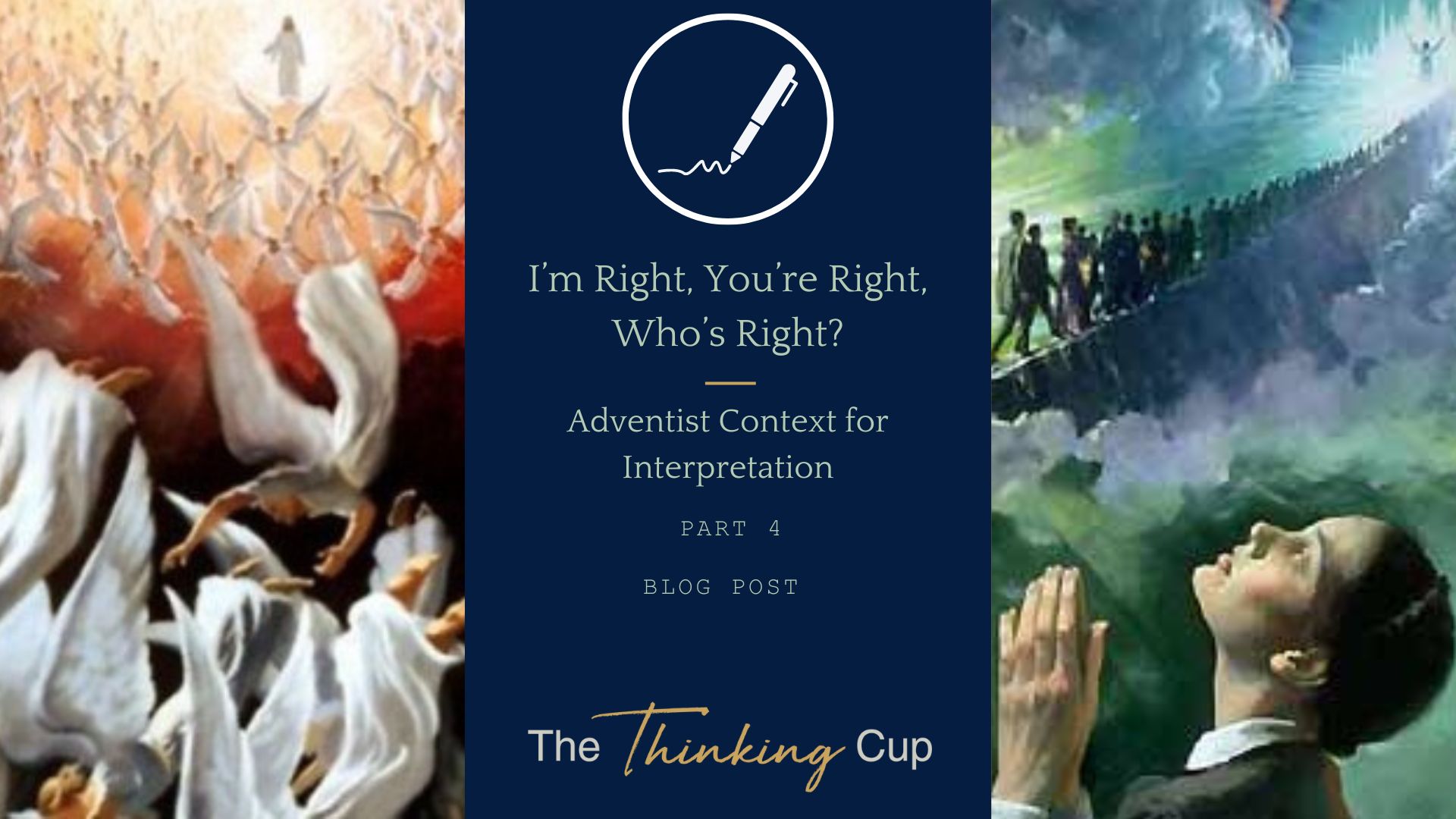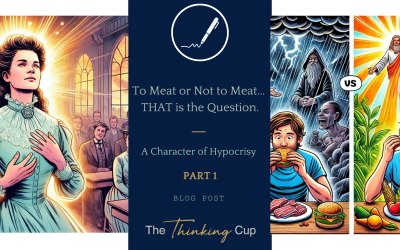While we have been working to understand better inspiration, methods of studying the Bible, and what context means in Biblical interpretation, I will direct our attention to how these ideas and concepts are used inside the Adventist framework of Biblical interpretation. It is important to remember the most important framework for the Adventist lens of interpretation: the Great Controversy Theme and Ellen G. White’s writings. We will first summarize and refresh our memories of the historical context of Ellen’s writings and how they get used with regard to an Adventist interpretation. Then, we will discuss the primary ‘key’ to unlocking and understanding the Adventist framework, the Great Controversy Theme. This will help us understand why Adventist Theology arrives at different conclusions from others. In my opinion, this is the primary reason Christians should be leery of their interpretations, especially on their ‘unique additions’ to mainstream Christianity. But I’m getting ahead of myself. (If you haven’t read the first three posts, please pause and do so before moving forward.)
As a quick reminder, Ellen White is very clear about her expectations for others reading her writings. In a letter written to J.H. Kellogg on July 2nd, 1900, who would later leave the church because of his belief that Ellen White was a false prophet, Ellen writes:
“The Holy Ghost is the author of the Scriptures and of the Spirit of Prophecy. These are not to be twisted and turned to mean what man may want them to mean, to carry out man’s ideas and sentiments, to carry forward man’s schemes at all hazards.” [1]
Letting her own words do the heavy lifting and being careful not to misinterpret her own words, Ellen believed the Holy Ghost was the author of both the Scriptures and her own writings. She also did not want other people to twist the Bible and her writings to mean what others wanted them to mean, but rather, she meant them to mean because she believed that God had written all of her writings through her pen.
Understand the historical context of this letter. Ellen White was writing to a man who would eventually come to doubt the inspiration of her writings, so this letter was designed to help convince Kellogg that her writings were directly inspired by the Holy Ghost. This was also the last 15 years of her life. She had already spent decades building her persona of being divinely inspired, so anyone who would dare to disagree would be sure to get letters and dreams condemning these actions.
Two years later, on August 4th, 1903, Ellen wrote a letter to the leaders of the Seventh-day Adventists in charge of the medical work. Apparently, some of these leaders were also straying in their understanding of Ellen White’s divine appointment:
“If I act conscientiously, I must meet the crisis, for I believe that the precepts which the Lord has given concerning His work in the past, and at the present time, point out the right way. And His plans, His thoughts, are as much higher than man’s plans, man’s thoughts, as the heavens are higher than the earth. God’s voice is to be heard. His wisdom is to guide us. We must not be broken up by any human wisdom or devising. God has outlined His plan in His Word and in the testimonies He has sent to His people.” [2]
If one reads the entire letter, one can see that she felt the need to step in and condemn the workers for the positions these workers were taking. She felt so concerned about this that she wrote:
“I am sorry to be compelled to take the position that I am forced to take in behalf of God’s people. In taking this position, I am placed under the necessity of bearing the heavy burden of showing the evil of the plans that I know are not born of heaven.” [3]
In the context of the letter that Ellen wrote, she expressed her deep concern for the direction the medical leaders were taking and believed that their direction was contrary to God’s desire. God had shown her that they were straying! And their direction was going against her writings, which means they were rebelling against God himself.
“Oh, how sad it is that men allow themselves to be so wrought upon by the enemy that they dare venture to exalt their finite judgment in opposition to God’s plans and purposes. Man’s authority bears the signature of man. We are not to permit the rank and file of our people to come under the generalship of the weak, confused sentiments of man. God’s authority is to stand supreme. And I must call upon His people to recognize His authority, which bears the evidence of its divine origin. Every believer is called upon to unite inseparably with God’s authority.” [4]
Understand that this statement was made after she claimed that God’s plan was “outline…in His word and in the testimonies He has sent to His people.” (AKA, the writings that she had written, the Testimonies to the Church.)
A year later, in 1904, she wrote in volume 8 of Testimonies For The Church, further emphasizing that God had directly spoken to the church through her own words. They are NOT to be turned away from!
“We must follow the directions given through the spirit of prophecy. We must love and obey the truth for this time. This will save us from accepting strong delusions. God has spoken to us through His word. He has spoken to us through the testimonies to the church and through the books that have helped to make plain our present duty and the position that we should now occupy. The warnings that have been given, line upon line, precept upon precept, should be heeded. If we disregard them, what excuse can we offer?” [5]
Another year passed, and she wrote a letter to Elder O.A. Olsen on January 30th, 1905, which further expressed and reinforced the concept that her writings were given to the church from God and should not only never be questioned but also bear the test of investigation because they were from God.
“I have written many books, and they have been given a wide circulation. Of myself I could not have brought out the truths in these books, but the Lord has given me the help of His Holy Spirit. These books, giving the instruction that the Lord has given me during the past sixty years, contain light from heaven, and will bear the test of investigation.” [6]
In a letter written to her Brothers and Sisters in Boulder and Denver on August 27th, 1906, nine years before she would pass away, Ellen White was unchangeable in her stance. She would now state that her writings were not only from God but that they should be recognized as eternal truth.
“It has been presented to me that, so far as possible, I am to impart instruction in the language of the Scriptures; for there are those whose spiritual discernment is confused, and when their errors are reproved, they will misinterpret and misapply what I might write, and thus make of none-effect the words of warning that the Lord sends. He desires that the messages He sends shall be recognized as the words of eternal truth.” [7]
Let me summarize these letters in statements Ellen White claimed with regard to her writings:
-
- 1900 – The Holy Ghost is the author of the Scriptures and of the Spirit of Prophecy.
- 1903 – God has outlined His plan in His Word and in the testimonies He has sent to His people.
- 1904 – He has spoken to us through the testimonies to the church and through the books that have helped to make plain our present duty and the position that we should now occupy.
- 1905 – light from heaven, and will bear the test of investigation
- 1906 – He (God) desires that the messages He sends shall be recognized as the words of eternal truth.
I do not believe it would be taking Ellen G. White out of context to state the following:
Ellen G. White believed her writings were authored by the Holy Ghost, just as the Scriptures. Her writings, especially the Testimonies for the Church, outlined the direct plan from God for the church, and through her books, one can make plain our present duty and the position that we should take with regard to these plans. She further believed that her writings were light from heaven that would bear the test of investigation. Meaning that anyone who read, studied, and put her writings against the Word of God, her writings would always come out with flying colors and not contradict the Bible. Furthermore, God desires that her writings, because they are divinely inspired, should be recognized by the church as the words of eternal truth.
It is for this reason that Adventist scholars can write statements like this:
“In Ellen White’s mind there was perfect harmony between the Bible and her writings because “the Holy Ghost is the author of the Scriptures and the author of the spirit of prophecy.”145 Therefore, “it is impossible that the teachings of the Spirit should ever be contrary to that of the word.”146 This unique relationship between the Bible and the Spirit of Prophecy has given the latter a place above all extra-biblical sources. Consequently in the study of the Bible the writings of the Spirit of Prophecy (Ellen White) hold a superior position over other research tools.” [8]
I hope the lens through which Adventist Scholarship interprets Biblical topics is becoming clear. Their interpretation must align with Ellen G. White’s statement on the topic. Furthermore, from Part 3 of this series, remember that the Great Controversy Theme is the key that unlocks all confusion and unifies the Adventist church’s interpretations. We can also better understand why the Adventist church understands the Great Controversy Theme as something that “we didn’t discover; it was given to us.” [9] This is the safest and most accurate understanding of the origin of the Great Controversy Theme, as it does not derive from the Scriptures; it is solely derived from and given to the Seventh-day Adventist church through Ellen G. White’s writings.
The Great Controversy Theme, given to the Adventist Church through the writings of Ellen G. White, their divinely appointed and ‘inspired by the Holy Ghost’ prophet, is what sets the interpretation of the Seventh-day Adventist church apart. This is predominantly why they see themselves as the Remnant Church in Revelation 12:17. We will explore this concept more later but understand the lens of interpretation. Because Ellen G. White claims the Adventist Church as the Remnant in Revelation 12 and 14, the church’s interpretation must align with these claims. Otherwise, they are opposing the supposedly divine inspiration of their prophet.
Understanding what sets the Adventist interpretation apart from others comes into focus when you understand the role of Ellen G. White and the Great Controversy Theme. Think of these two components as the aperture and shutter in a camera lens. They both help to bring specific topics, subjects, and interpretations into Adventist clarity. Notice I didn’t say, into clarity. These two items only help one to understand why Adventism interprets topics the way they do. It doesn’t make their perspective and interpretation grounded in truth.
Herbert Douglass ends his article with this statement:
“For another example of how the GCT clarifies the distinctiveness of Adventist theology we may point to Adventist eschatology. The Adventist eschatological framework sets us apart from every other denomination that speaks of the end of the world because it is governed by the GCT. The distinctly Adventist view is formed by a “mutually supportive cluster” of ideas, including conditional immortality, seventh-day Sabbatarianism, a premillennial historicist eschatology, acceptance of the gift of prophecy in the ministry of Ellen White, teachings about the priestly work of Christ in the heavenly sanctuary, and a prepared people by His grace.
This “mutually supportive cluster” of ideas that marks Adventist eschatology exists today because the GCT informs all areas of Adventist thought. Every area, because it unfolds from this organizing principle, is coherent and interactive with all other areas. Helping believers to be restored physically, mentally, emotionally, and spiritually is the purpose of the gospel and everything to do with the Advent. They are people the Spirit has prepared to meet the Coming Lord, the people John foresees in Revelation 14:12: “This calls for endurance on the part of God’s people, those who obey God’s commandments and are faithful to Jesus” (TEV). When the controversy is over, the purpose of the gospel will be seen as the vindication of the wisdom, power, and love of God.” [10]
I have heard many well-meaning Seventh-day Adventists share their concern for my ‘ridged’ view of Ellen G. White, exclaiming, “Mike, I have studied the fundamental beliefs without Ellen White… just the Bible… and everything that I believe is based on only the Bible. I don’t think we should use Ellen White or (insert whatever the concern might be) to interpret the Bible. It should only be the Bible!”
I appreciate and understand this sentiment. There needs to be a clearly determined line between the Seventh-day Adventist Church’s (proper) beliefs and teachings through all of its marketing arms and the beliefs of an individual who attends an SDA Church.
Based on the quote above, the Great Controversy Theme, (1) given to the SDA Church through Ellen G. White’s visions and writings, (2) informs all areas of Adventist thought. This includes the concept of the afterlife, accepting Ellen White as a prophet, and how a person should view Jesus as the high priest, among countless other areas. (3) The ‘mutually supportive cluster’ of ideas is unified because of the Great Controversy Theme.
It is vital that a person understand this concept. Not because you must agree with it but because you need to understand the lens through which Adventist interpretation occurs. The interpretation must align with Ellen G. White and honor the Great Controversy Theme to correctly understand any passage or concept in Scripture for an Adventist. This is why their understanding of the importance of the Law, Sabbath, Sanctuary, Salvation, Perfection of Character, Sanctification, alcoholic consumption, Judgment, Seal of God, Mark of the Beast, the Day of Atonement, Remnant theology, among many other topics, all connect to the vindication of the character of God. Because this concept ties into their view that God’s character has been attacked in a pre-creation controversy in heaven derived from the pen of Ellen G. White that is called the Great Controversy Theme.
Remember this as we examine several examples of how interpretations can be taken out of context and cause significant damage to the body of Christ. I will explore these examples further in my next post!
In Christian Love,

[1] Manuscript Releases [Nos. 97–161, 1958–1964], vol. 2 (Ellen G. White Estate, 1993), 189.
[2] Manuscript Releases [Nos. 921–999, 1982–1983], vol. 12 (Ellen G. White Estate, 1993), 68–69.
[3] Manuscript Releases [Nos. 921–999, 1982–1983], vol. 12 (Ellen G. White Estate, 1993), 68.
[4] Manuscript Releases [Nos. 921–999, 1982–1983], vol. 12 (Ellen G. White Estate, 1993), 69.
[5] Testimonies for the Church, vol. 8 (Pacific Press Publishing Association, 1855), 298.
[6] Manuscript Releases [Nos. 19–96, 1941–1957], vol. 1 (Ellen G. White Estate, 1993), 140–141.
[7] Manuscript Releases [Nos. 260–346, 1971–1973], vol. 5 (Ellen G. White Estate, 1993), 151.
145 Letter 92, 1900.
146 Great Controversy, p. vii.
[8] Gerard P. Damsteegt, “Ellen White on Theology, Its Methods, and the Use of Scripture,” Journal of the Adventist Theological Society 4, no. 2 (1993): 129.
[9] Douglass, “The Great Controversy Theme: What It Means to Adventists.”
[10] Douglass, “The Great Controversy Theme: What It Means to Adventists.”




0 Comments